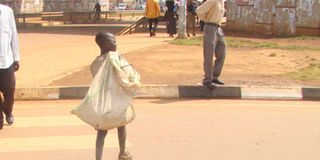School children demand an end to child labour

A juvenile who is one of the bigger number that collects plastic and scrap material crossing the road at Bwaise near Kampala. PHOTO BY EPHRAIM KASOZI
School children have asked government to explain its commitment to end rampant child labour in the country.
The children, in both primary and secondary schools, said despite several efforts and the laws in place, child labour has persisted, thereby posing dangers to their growth and health.
“We are always abused. Is it right for children to work in construction companies? What solution do you have for those who employ children in bars and other places and what is government doing to such entrepreneurs?” Hamidu Kamoga, a secondary school student from Comprehensive College, Kitetikka in Wakiso District said.
Frank Mugisha, a Primary Six pupil of Railway Primary School in Nsambya questioned the plans that government and the civil society have to block employers from recruiting youngsters in risky enterprises like bars and construction sites.
The young people made the demands during celebrations to mark the commemoration of the World Day Against Child Labour 2011 at Kyambogo University. The celebrations attracted workers organisations, activists and children in and out of school under the theme; ‘Warning! Children in hazardous work; end child labour.’
A International Labour Organisation (ILO) report released this month warns that a staggeringly high number of children are still caught in hazardous work with some 115 million of the world’s 215m child labourers, under 18 years.
“…Although the overall number of children aged 5 to 17 in hazardous work declined between 2004 and 2008, the number aged 15 to 17 actually increased by 20 per cent during the same period.
It increased from 52 million to 62 million,” reads the report.
Ms Akky de Kort, the ILO Chief Technical Advisor on the International Programme on the Elimination of child labour in Uganda said there is need to prioritise arrangements to tackle the rampant cases of child labour.
“It is difficult to establish facts and figures about Child Labour, that is why we have to apply different techniques thus creating relationships with people involved in child labour,” said Ms Kort emphasising that children below 14 years are not supposed to work while children aged 14 to 17 are supposed to do light work.
Ms Helen Grace Namulwana, the Platform for Labour Action senior programme Officer in charge of child labour said there is need to enhance the fight for the children at the risk of falling into labour because it is their right to go to school.
“Why they work is to supplement family income to offset costs for family survival and education. But of the two issues, education becomes a luxury. We criticise any acts that get said children involved in child labour and we believe that every child has a right to education, so nothing should stand in the way to observing those rights,” said Ms Namulwana.
She identified poverty and general awareness levels resulting from some illiterate parents who don’t find a problem in dropping their children out of school.
Mr Usher Wilson Owere, the Chairman General of the National Union of Trade Unions said child labour is common in the informal sector where children are involved in selling small items on streets, acting as maids and or work on construction sites.
“Current studies show that the problem still exists. What is pertinent is the lack of awareness of the availability of the good legal and policy framework to address the problem,” said Mr Owere.




